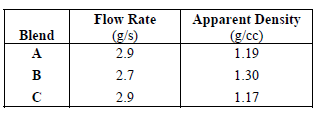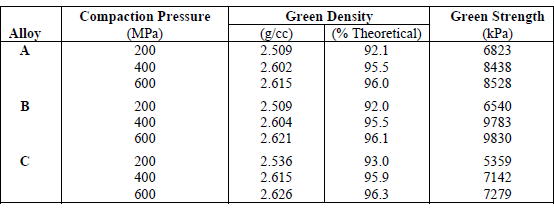New alloy developments enhance PM aluminium application opportunities, Part 1
The first of these twin papers was presented by Paul Bishop (Dalhousie University, Halifax, Nova Scotia, Canada) on behalf of his co-authors, Randy W Cooke (Dalhousie University) and Richard L Hexemer Jr. and Ian Donaldson (GKN Sinter Metals LLC, Auburn Hills, USA).
This development was aimed at enhancing the capabilities of materials for PM structural part applications. The reported work built on previous studies from the same collaborative team that had revealed the development of a new Al-Cu-Mg PM alloy (Al- 2.3Cu- 1.6Mg- 0.2Sn) and specifically related to the potential benefits of making small additions of zirconium to this base alloy system.
Zirconium is recognised to confer a range of benefits in wrought Al alloys (e.g. creation of precipitation hardening, improvement in recrystallisation resistance), but its use in press/sinter PM alloys had not been previously tested.
The three powder mixes used in this study (Table 1) were all based on the emerging Al-Cu-Mg composition. Alloy A was the “base” alloy comprising air atomised elemental aluminium, inert gas atomised elemental magnesium and tin and an Al-50Cu masteralloy.
Alloy B comprised the same ingredients together with an Al-50Zr masteralloy as the source of zirconium. Alloy C had the same bulk composition as B, but, in this case, the zirconium was prealloyed in the base aluminium powder rather than being added as a masteralloy.
Initially, it was confirmed that the Zr additions exerted no significant influence on either flow rate or apparent density of the base alloy (Table 2). Green density and green strength were assessed next for a range of compaction pressures (Table 3).
The results for alloys A and B were fairly comparable, although the zirconium-containing alloy B showed somewhat increased green strengths. Alloy C showed a lower increase of green strength as compaction pressure was increased and it was proposed that this resulted from the pre-alloyed nature of the Zr addition.
It was found that all three alloys sintered to near full theoretical density (Table 4) and the comparative levels of sintered mechanical properties were particularly interesting (Table 5). No influence of adding Zr in masteralloy form on properties was observed. However, alloy C, with the zirconium addition in prealloyed form, showed modest increases in yield strength and UTS, but a very significant increase in elongation value to 10%.
However, the most striking advantage of using prealloyed Zr was revealed, when the dimensional changes in sintering of the three alloys were assessed.
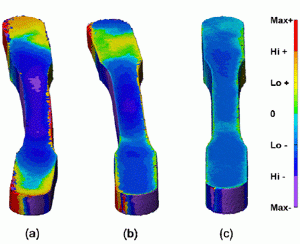
Fig. 1 Images acquired through 3D laser scanning that depict the variations
in dimensional change throughout the volume of dog bone specimens
(a) Alloy A, (b) Alloy B, and (c) Alloy C. (Courtesy MPIF)
Direct measurements on sintered TRS bars (Table 4) indicated more uniform shrinkages with alloy C than with the other two alloys, but the comparisons were shown even more dramatically using a 3-D laser scanning technique. In the maps derived from this technique, the extent of dimensional change is indicated by a colour coding.
The 3-D maps in Fig. 1 showed significant shrinkage variations and warpage in Alloy A, marginal improvements for Alloy B, but uniform shrinkage (indicated by the uniform colour of the image) and absence of warpage for Alloy C.
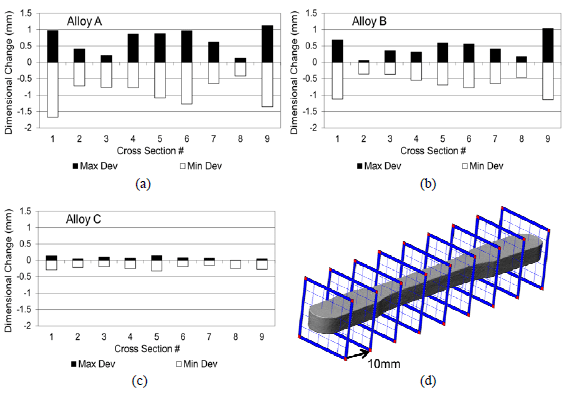
Fig. 2 Quantitative measurements of the maximum and minimum dimensional change variations (mm) acquired for 9 individual cross sections from sintered dog bones fabricated from (a) Alloy A, (b) Alloy B, and (c) Alloy C. (d) 3D image illustrating the locations of where cross sectional analyses were completed. (Courtesy MPIF)
To quantify these comparisons, information for a number of 2-D sections of the bars was derived. These results (Fig. 2) emphasised the exceptionally small dimensional deviations observed for Alloy C.
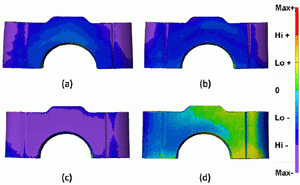
Fig. 3 Images acquired through 3D laser scanning that reveal dimensional changes in camshaft beating caps processed from (a) alloy A, (b) Alloy B, (c) Alloy C and (d) the alloy used in commercial production of the part (AC2014) (Courtesy MPIF)
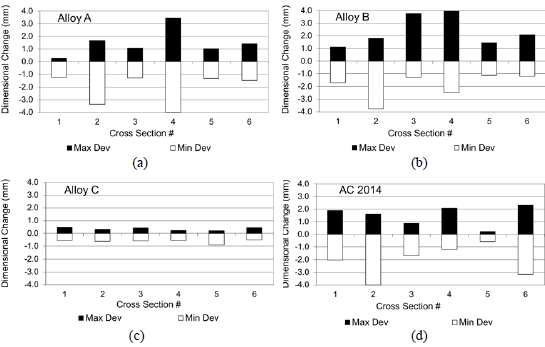
Fig. 4 Quantitative measurements of the maximum and minimum dimensional change variations acquired from vertical cross sections within camshaft bearing caps processed from (a) Alloy A, (b) Alloy B, (c) Alloy C and (d) AC2014 (Courtesy MPIF)
These comparisons were further confirmed on the basis of assessing camshaft bearing cap parts, processed at the GKN Sinter Metals Condover plant from these experimental alloys. Very comparable results, to those on laboratory-processed bars, were derived from direct dimensional measurements (Table 6) and 3-D scanning (Figs. 3 and 4) and, in this case, the comparisons also included the standard commercial grade, AC-2014, used for this bearing cap application.

Table 6 Sintering response measured for the bearing caps processed from the 3 experimental alloys and the commercial system AC2014 (Courtesy MPIF)
It was concluded that this new alloy development has potential benefits in two areas:
- It offers an enhanced combination of mechanical performance and dimensional control capability compared with standard commercial PM aluminium alloys
- It may open up the possibility of advancing the level of geometrical complexity achievable in PM aluminium products, in order to form challenging features such as thin walls.
News | Articles | Market reviews | Search directory | Subscribe to e-newsletter




